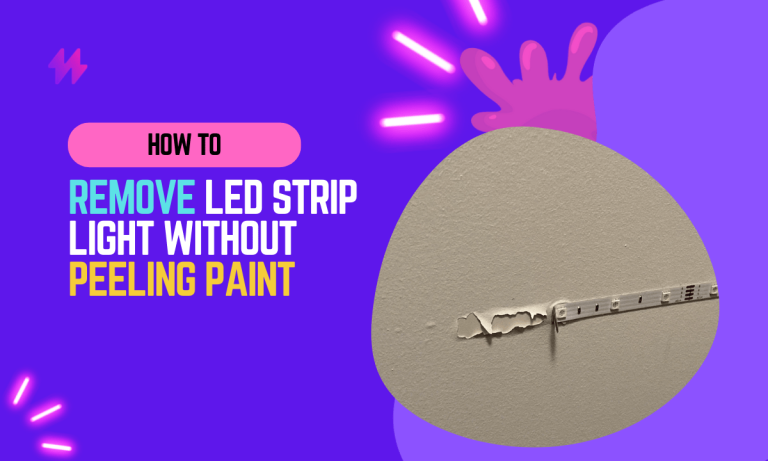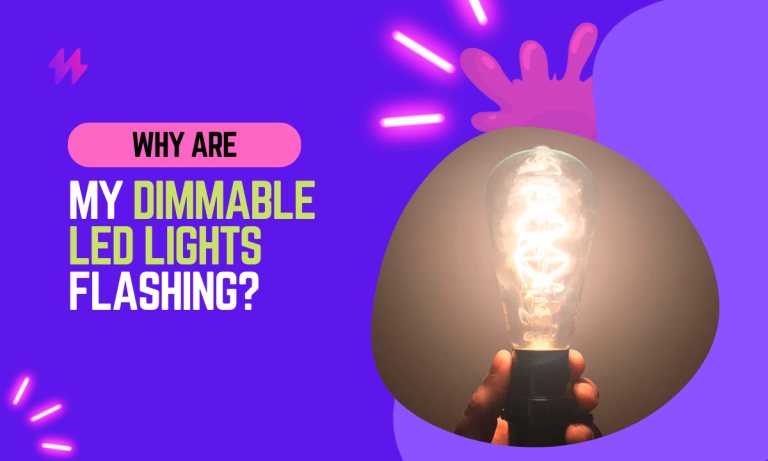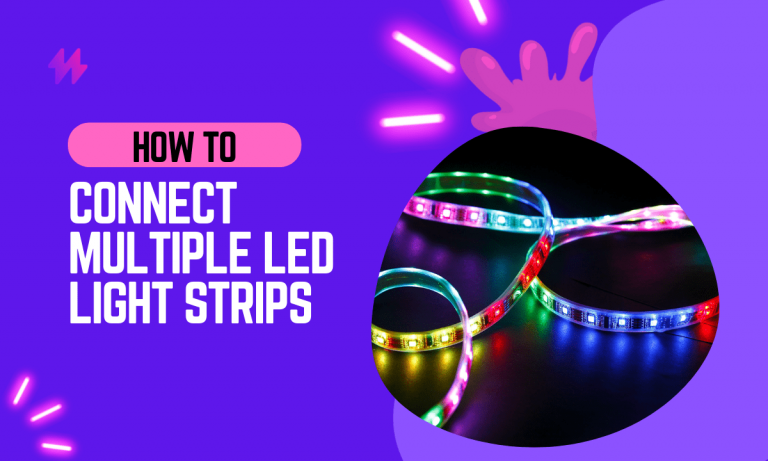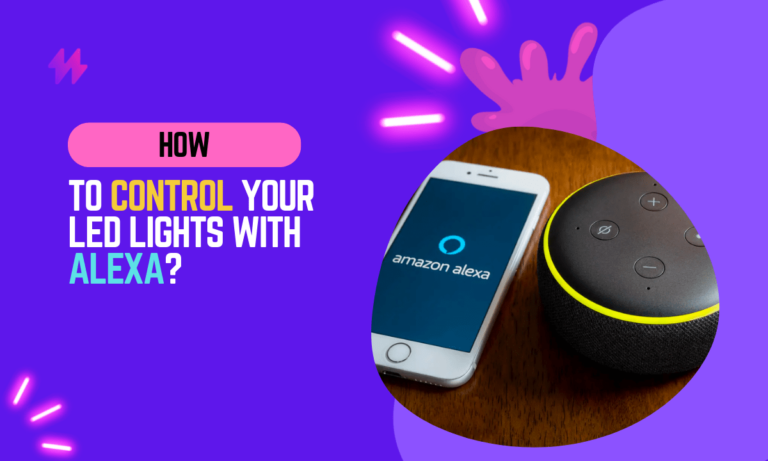10 Reasons Why LED Light Flickers and How to Stop LED Light Flickering
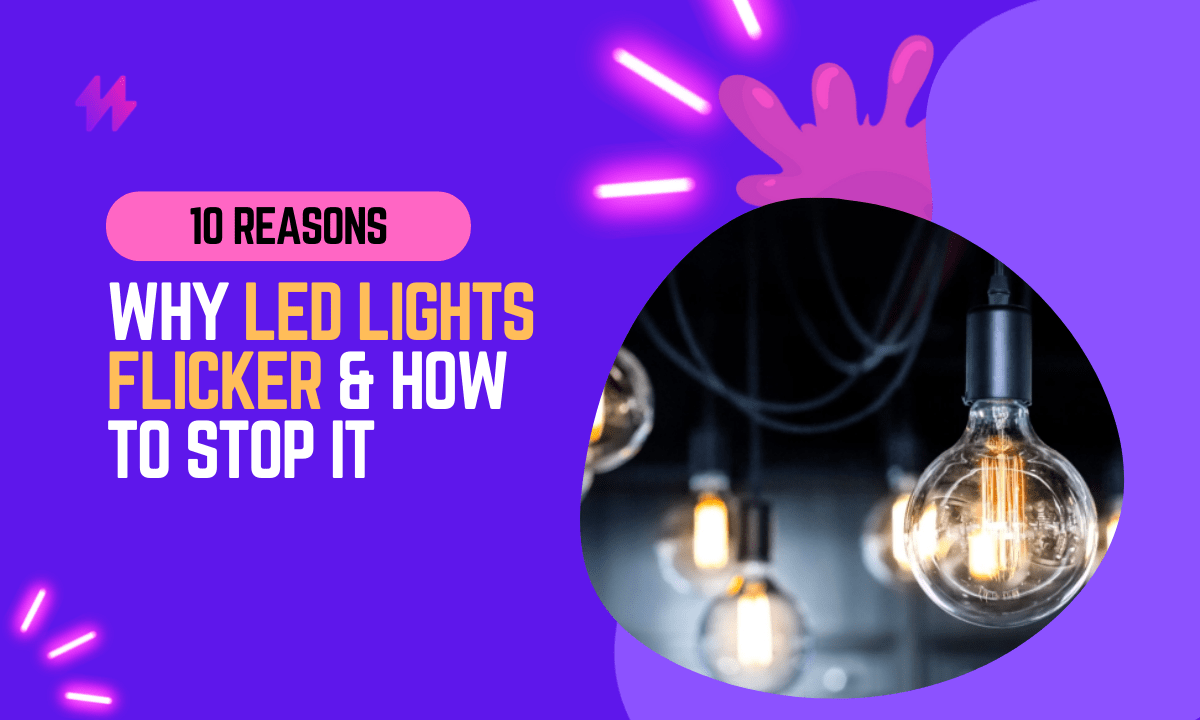
LED light flickering is an issue that has been present in LED lights for a while now. Though it is not a major problem, it can annoy some people.
Though LED lights are great, many people have found they flicker, even if the bulb is new.
If your LEDs are flickering, you’re not alone.
In this article, we will discuss the various reasons why LED light flickering occurs and how to stop LED light flickering from happening.
LED light flickering can be frustrating, but understanding its causes can help you find effective solutions. Regular flickering might stem from incompatible dimmer switches or issues with the LED driver, so it’s important to check these components if you want to maintain a steady illumination with your LED lamps. These potential flickers can significantly affect your overall lighting experience, hence considering an energy-efficient lighting solution could be wise for any lighting projects.
10 Reasons Why LED Lights Flicker: How to Stop LED Light Flickering
Below, we’ve listed 10 of the most common reasons why LED light flickers and how to stop LED lights from flickering.
Understanding the nuances of why LED lights flicker can significantly enhance your lighting experience, ensuring your home remains bright and inviting. By addressing potential causes such as faulty LED drivers or incompatible dimming systems, you can effectively avoid flickering and enjoy a steadier light output throughout your space.

10 Reasons Why LED Light Flickers: How to Stop LED Light Flickering
One of the most common reasons for flickering LED lights is that the fixtures are improperly sized for the bulbs. If your fixtures are too small, they will not be able to properly dissipate the heat generated by the LEDs, causing them to flicker.
To avoid this issue, make sure that you use fixtures that are correctly sized for your LED bulbs.
Choosing the right fixtures for your LED light bulbs is crucial to prevent flickering, as never using fixtures designed for LED lights can lead to problems. Proper installation ensures that the brightness remains consistent, allowing you to fully appreciate the energy efficiency and long-lasting performance of your LED diodes.
10 Reasons Why LED Light Flickers: How to Stop LED Light Flickering Including Dimmer Switches
Dimmer switches are another common cause of flickering LED lights. Dimmers work by reducing the amount of power that is sent to the lightbulb. When used with LEDs, dimmers can cause the bulbs to flicker or strobe.
To avoid this issue, make sure that you use a dimmer switch that is specifically designed for use with LED lights.
It’s crucial to ensure that your dimmer switches are compatible with LED fixtures to prevent flickering. Understanding how the flicker frequency impacts light output can lead to better lighting choices in your home, creating a world brighter with consistent illumination.
Understanding Loose Wiring: 10 Reasons Why LED Light Flickers and How to Stop LED Light Flickering
Loose wiring is another common cause of flickering LED lights. If the wires that connect your LED bulbs to the power source are loose, they can cause the bulbs to flicker. To avoid this issue, make sure that you check your wiring regularly and tighten any loose connections.
Also read: How to hide Under-Cabinet Lighting wires
Loose wiring in your lighting setup can disrupt the power flow and lead to flickering in your LED lights. It’s vital to inspect the connections for your light bulb regularly to ensure reliable performance, as loose wires not only cause flickers but may also pose electrical hazards. The compatibility of LED dimmers with your existing fixtures is key to maintaining optimal light output and avoiding unholy flicker cycles.
Understanding Why Faulty Bulbs Cause LED Light Flickers and How to Fix Them
Faulty bulbs are another common cause of flickering LEDs. If an LED bulb is damaged or defective, it can cause the bulb to flicker.
To avoid this issue, make sure that you only use high-quality LED bulbs from reputable manufacturers.
In addition to faulty bulbs, an incompatible light switch can also be a possible cause of flickering in your LED lights. Keeping your fixtures updated and ensuring compatibility between your lamp switch and LED driver will help enhance your overall light output and reduce the chances of intermittent flickering.
Understanding the Impact of Poorly Made Lights on LED Light Flickering: 10 Reasons and Solutions
Poorly made lights are also a common cause of flickering LEDs. If an LED light is not made properly, it can cause the bulb to flicker. To stop LED light flickering, make sure that you choose your LED lights carefully and only purchase lights from reputable manufacturers.
LED light flickering can also be a symptom of a poorly designed or manufactured light bulb, leading to inconsistent performance. It’s essential to be aware of the potential for LED flickerings, as they can result from cheap lights or unsuitable matchings with mains electricity, impacting your ceiling lights and other fixtures.
Top Factors Behind LED Light Flickering: Understanding Voltage Issues
Voltage issues are another common cause of flickering LEDs. If the voltage supplied to your LED bulbs is too high or too low, it can cause the bulbs to flicker. To avoid this issue, make sure that you check the voltage supplied to your LED lights regularly and adjust it as needed.
Voltage issues are another common cause of flickering LEDs. If the voltage supplied to your LED bulbs is too high or too low, it can cause the bulbs to flicker. To avoid this issue, make sure that you check the voltage supplied to your LED lights regularly and adjust it as needed. An inappropriate LED power supply can exacerbate flickering problems, particularly when combined with old dimmers or traditional bulbs. Addressing the reasons behind flickering can ensure that your lighting stays consistent and enhances overall light output, preventing visually distracting flashes in your spaces.
Understanding the Impact of Dirty Sockets on LED Light Flickering
Dirty sockets are another common cause of flickering LEDs. If the socket that an LED bulb is screwed into is dirty, it can cause the bulb to flicker.
To avoid this issue, make sure that you clean your light sockets regularly with a soft cloth.
Also read: How to choose between 2700K vs 3000K lighting
Maintaining clean sockets is essential for preventing flickering, as dirt can disrupt the connection and cause the light bulb to experience irregular power flow. Regular maintenance of your LED lights can help ensure they function properly, avoiding issues related to flicker effects and providing consistent light output in your home.
Understanding Interference from Other Lights: Reasons and Solutions
Interference from other lights is also a common cause of flickering LEDs. If there are other light sources nearby that are emitting electromagnetic fields, they can interfere with the LED bulbs and cause them to flicker.
You can avoid LED light flickering by making sure that you shield your LED lights from any nearby light sources.
To further avoid flickering in your LED lights, understand that fluorescent lighting and old incandescent bulbs may contribute to voltage fluctuations that impact performance. By identifying the possible causes of flickering, such as incompatible dimmable lights or issues with the LED driver, you can implement effective solutions and enhance your overall lighting experience.
Understanding Temperature Issues: 10 Reasons Why LED Light Flickers and How to Stop Them
Temperature issues are another common cause of flickering LEDs. If the temperature around an LED bulb is too hot or too cold, it can cause the bulb to flicker. So try to keep your light as cool as possible to avoid LED flickering.
Also read: How to avoid Color temperature inconsistencies
In addition to temperature issues, old incandescents and halogen downlights can also contribute to flickering problems in LED setups. By ensuring all components work together harmoniously, including the LED driver and lamp circuit, you can enhance the full brightness of your LED lights and minimize any visible flicker.
Faulty Drivers: Understanding LED Light Flickering Issues
Faulty drivers are the last common cause of flickering LEDs. The driver is part of the LED light that converts the AC current into the DC current. If the driver is faulty, it can cause the LED bulb to flicker. So, ensure you replace any wrong drivers as soon as possible.
These are just a few of the most common causes of flickering LED lights. You can stop your LED lights from flickering by troubleshooting your lights and addressing these issues.
In the lighting industry, it’s vital to comprehend how factors like faulty LED drivers and incompatible fixtures can cause flickering in your LED lights. By addressing these problems, you can avoid issues such as one-shot flickering and ensure your LED ceiling light delivers consistent light output without the risk of electric-induced fire or malfunction.
Summary and Solutions: 10 Reasons Why LED Light Flickers and How to Stop Them
In conclusion, flickering in LED lights can be both a nuisance and a symptom of underlying issues within a lighting system, encompassing a range of causes from simple to complex. The reasons for flickering can vary widely, including poor connections, incorrect dimmer switches, voltage fluctuations, and the incompatibility of lighting components. Addressing these issues is crucial not only for the comfort and safety of the environment but also for ensuring the longevity and efficiency of the LED lighting system. To effectively stop flickering, it is essential to first identify the specific cause, whether it’s inspecting the quality of installation for loose connections or ensuring that the dimmer switches are compatible with LED technology. Often, upgrading outdated dimmers or ensuring that the electrical wiring provides a stable and adequate supply of power can resolve many of the flickering issues.
Moreover, as technology advances, new solutions to prevent flickering in LEDs have emerged, such as using LED-optimized dimmers or incorporating dedicated drivers with better voltage regulation. For households and businesses experiencing persistent flickering, consulting with a lighting expert or electrician can provide tailored solutions that address not just the symptoms but the root of the problem. Regular maintenance checks and timely updates of lighting hardware can also preempt problems of flickering before they start, ensuring that LED lighting continues to provide reliable and quality illumination. Thus, by taking a proactive approach to understanding and maintaining LED lighting systems, users can enjoy the full range of benefits offered by LEDs, including their energy efficiency, long lifespan, and superior light quality, without the disruption of flickering.
10 Reasons Why LED Light Flickers And How To Stop LED Light Flickering | Common Causes of LED Light Flickering
LED light flickering can result from various issues, causing annoyance and affecting eye comfort. Understanding the 10 reasons why LED light flickers and how to stop LED light flickering is essential for maintaining consistent light output. Loose lightbulb contacts or wiring can lead to sparks and intermittent connections, resulting in rhythmic flicker or fast flickerings. Old style incandescent bulbs and incompatible volt-dimming systems often create problems as they produce different brightness levels, leading to noticeable flickering, especially in mains-powered light sources. An LED driver that doesn’t handle voltage fluctuations properly can contribute to this issue, impacting the performance of night lights or switched-off lamps. Addressing these common causes can help ensure that your LED lights function reliably without the distractions of flickering.
10 Reasons Why LED Light Flickers and How to Stop LED Light Flickering | Loose Connections and Wiring Issues
Loose connections and wiring issues are common culprits behind LED light flickering. If wires connecting the LED bulbs to the power source are loose, the light output stops intermittently, causing a distracting flicker. An affected fixture might behave erratically, much like bicycle lights that flicker when their connections aren’t secure. Inspecting wire connections is crucial since a faulty connection can result in low frequency flashing, even if the LED driver doesn’t seem to be the problem.
Another significant factor involves the quality of the wiring used in the installation. Poorly insulated or damaged wires can lead to inconsistent power delivery, making bulbs flicker unpredictably. Tightening any loose connections can often resolve the issue. For some, even a tiny indicator light on the LED driver can reveal wiring problems. Taking immediate action to address these issues will ensure the reliable performance of your lighting. Understanding the 10 Reasons Why LED Light Flickers and How to Stop LED Light Flickering can help troubleshoot these common problems effectively.
Incompatible Dimmer Switches
Using standard dimmer switches with LED lights can lead to flickering issues. Many older dimmers are not designed to handle the low wattage that LED bulbs require. This mismatch often results in a flicker that is bothersome and may make users question why their light works inconsistently.
Finding a compatible dimmer switch is crucial to resolving this issue. Look for dimmers specifically labeled as “LED compatible.” These dimmers are engineered to provide the necessary support for LED technology. Implementing this simple change can significantly reduce flickering and align with the 10 Reasons Why LED Light Flickers and How to Stop LED Light Flickering.
Impact of Voltage Irregularities on LED Performance
Voltage irregularities can significantly affect LED light performance, leading to unwanted flickering. One of the 10 reasons why LED light flickers and how to stop LED light flickering lies in the fluctuations in voltage supplied to the lights. A flicker isn’t just an annoyance; it can indicate deeper electrical issues that may require attention. Understanding these voltage-related problems is essential for maintaining optimal LED functionality. By addressing voltage imbalances and ensuring a stable supply, homeowners can effectively reduce flickering and enhance their lighting experience.
Voltage Fluctuations and Their Effects
Voltage fluctuations can significantly impact the performance of LED lighting, causing noticeable flickering. These irregularities often stem from inconsistent power supply, which can lead to unstable current reaching the LEDs. This degradation not only affects the brightness but may also shorten the lifespan of the fixtures. Understanding the 10 reasons why LED light flickers and how to stop LED light flickering is crucial for maintaining optimal lighting conditions.
Frequent voltage spikes may cause LEDs to flicker rapidly, creating an unpleasant experience for users. Such fluctuations can result from various factors, including electrical load changes or issues within the electrical grid. Identifying the 10 reasons why LED light flickers and how to stop LED light flickering will help mitigate these voltage-related problems and ensure reliable performance for your lighting solutions.
Solutions for VoltageRelated Flickering
Voltage-related flickering can be addressed through several methods. One effective solution is to ensure that the electrical supply is stable. Using voltage stabilizers or surge protectors can help maintain consistent voltage levels, providing a steady power source for your LED lights. Following the guidelines in “10 Reasons Why LED Light Flickers and How to Stop LED Light Flickering” can give you a clearer understanding of how to implement such protective measures.
Another approach to resolve flickering involves consulting with a qualified electrician. They can assess your electrical system and identify any underlying issues that might be causing voltage irregularities. Professional inspection ensures that all connections are secure and that your circuit can handle the load of the LED lighting. Incorporating insights from “10 Reasons Why LED Light Flickers and How to Stop LED Light Flickering” can lead to effective solutions tailored to your specific situation.

